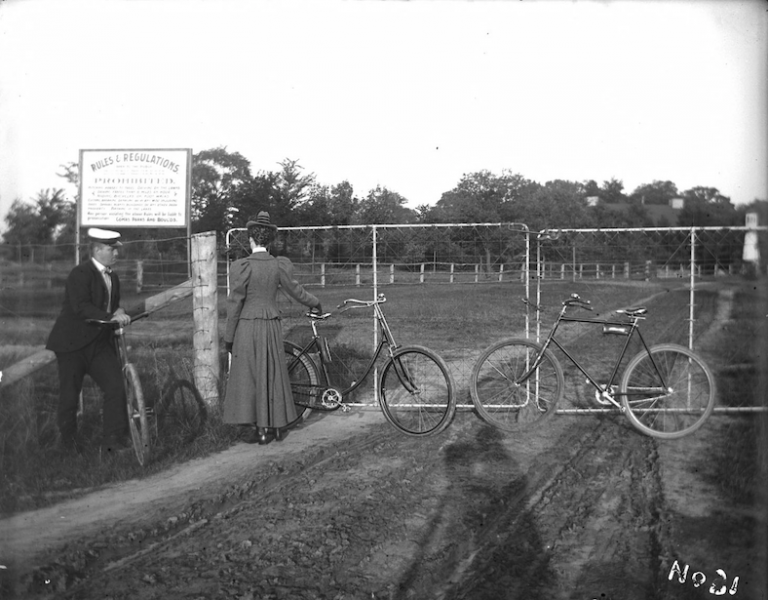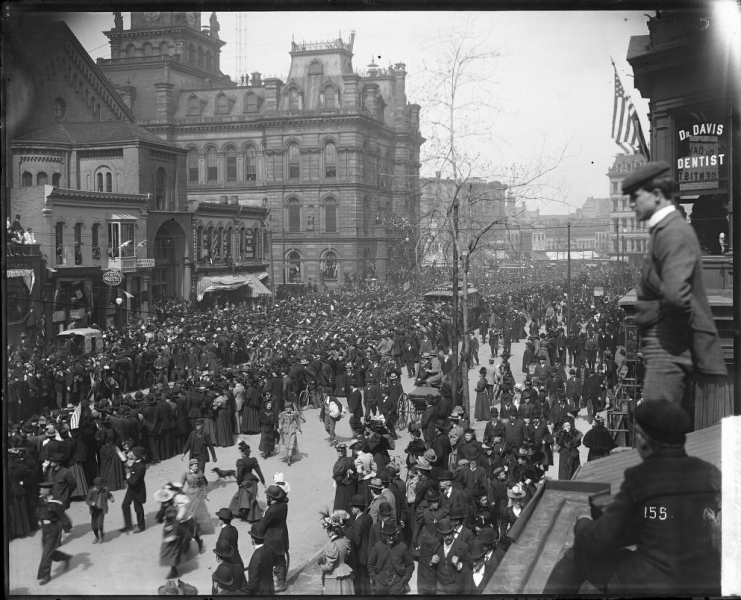
Continuing our journey into the history of the El Moore, here is a snapshot of Detroit in 1898, the birthday year of the El Moore!
Demographics:
In 1898, immigrants were continuing to come to Detroit in large numbers, just as they had been doing throughout the 19th century. In the last decade of the century, Detroit gained approximately 80,000 residents reaching a total population of around 285,000 by 1900. About 1/3 of city residents were foreign born and approximately 12% of Detroiters did not speak English.
Sports:
In 1898, the Detroit Tigers were a minor league team in the Western League. Players with names like Noodles Hahn, Buttons Briggs and Hunkey Hines were on the roster.
Bicycling was hugely popular in the city and its surrounding suburbs and Detroit was considered one of the best cities in the country for cycling. A city guide was published in 1898 which included favorite cycling routes in the city and to points outside, as well as cycling ordinances, such as keeping off the sidewalks and always having at least one hand on the handle bars. City ordinances also permitted businesses to install bicycle racks. Bicycle racing was a major sport at the time and people gathered at the Detroit Athletic Club, originally located on Woodward Avenue at Garfield, to watch the racers speed around a track. Races were also held on Belle Isle, and the winners could take home anything from a Singer piano to a burglar alarm. Several biking clubs opened up around town (The Detroit Wheelmen’s Club and the Detroit Rambler Club) , and outings around the city and out into the suburbs were regularly organized. Ladies were even seen biking around town, despite the disapproval of those with more Victorian sensibilities.
Politics:
Just one year before, Detroit mayor Hazen Pingree (Republican) was elected governor of the State of Michigan and resigned his position with the city reluctantly. He was hoping to be able to serve in both positions, but it wasn’t to be. Mayor Pingree really shook things up during his tenure in Detroit by adopting rather progressive views of the role of city government, but more on that in a future post. His replacement was William Cotter Maybury, a local businessman and Democrat. Maybury was an early investor in the nascent automobile industry who, along with people like William McMillan and D M Ferry and Thomas Palmer, provided funding in 1898 to Henry Ford for his first car company.
Industry:
The automobile industry was at its very beginnings at this time. The first automobile was driven on the streets of Detroit in 1894 by a man named Charles B King and, in 1898, men like Henry Ford, Ransom Olds, the Dodge and Fisher brothers were all just beginning to make headway into this new industry that would eventually dominate the city of Detroit and give it its identity at the Motor City. As with bicycles, automobile races were being organized around town and were tremendously popular with the public. The Detroit Automobile Company, which was being organized in 1898 by Henry Ford in his first foray into this new industry, ended up a bust. The company lasted only 3 years, closing in 1901 after having produced only 3 cars. Ford would eventually go on to establish the Ford Motor Company in 1910.
Of course, manufacturing in Detroit didn’t begin with the automobile companies. In 1898, among the major industries in Detroit were railroad car manufacturers, pharmaceutical companies, and stove manufacturers. Also Dexter Mason Ferry’s seed company, located north of downtown on Woodward Avenue at Ferry Street (of course!) was going strong, suppling seeds to distributors across the country.
Electricity:
Electricity had come to Detroit in 1898, but it was certainly still in a transitional phase. The city had seen its first incandescent light bulb only 15 years earlier and by 1892 the Edison Illuminating Company of Detroit (of which Henry Ford was chief engineer in 1898) had a customer base of 550, mostly commercial. Gas lighting in homes was still common at this time, but forward thinkers knew that electricity was the wave of the future! This is in evidence at the El Moore which was set up for both gas and electricity when it was built.

Remember the Maine…
1898 was the year of Teddy Roosevelt’s Rough Riders and the Spanish American War, a thankfully brief war that lasted only a few months, from April to August, a result of the US involvement in Cuban Independence from Spain. There was a lot of excitement in the city as Detroit’s Naval Reserves were called to service and regiments from our National Guard marched through the streets of Detroit to the Union Depot on their way to training camp. Most of the young men of the city who didn’t return lost their lives to typhus and other disease due to poor sanitary conditions in their camps, rather than to fighting.
Coming soon, the story of Mayor Pingree, whom many consider to be the best mayor the city has ever seen!
